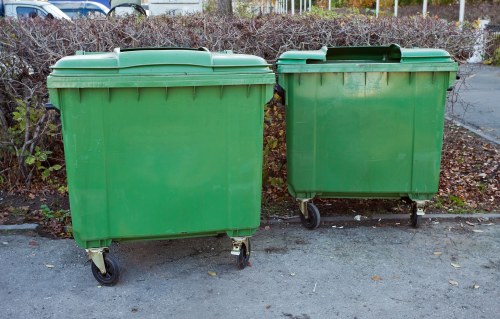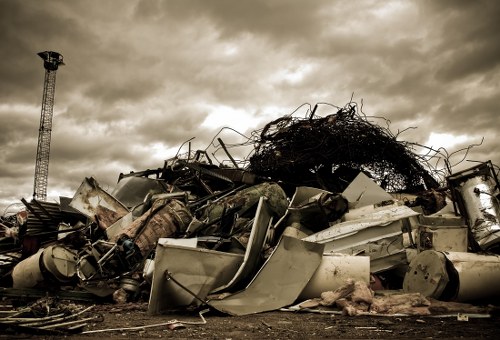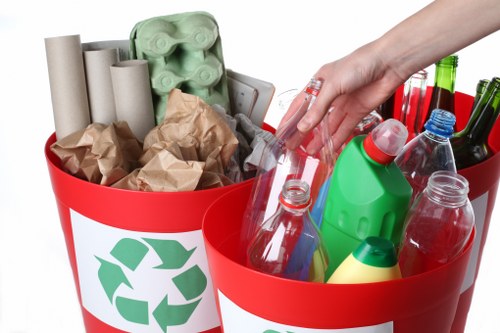Comprehensive Guide to Construction Waste Clearance in Hillingdon

Construction projects, whether large or small, inevitably produce significant amounts of waste. Proper management and clearance of this waste are crucial not only for maintaining a clean and safe environment but also for complying with local regulations. In **Hillingdon**, construction waste clearance has become an essential service, ensuring that debris is handled responsibly and efficiently.
Effective waste clearance involves the removal, transportation, and disposal of various types of construction materials, including concrete, wood, metal, and hazardous substances. This process requires specialized equipment and expertise to handle different kinds of waste, ensuring that materials are recycled or disposed of in an environmentally friendly manner.
Hiring a professional construction waste clearance service in Hillingdon can save time, reduce costs, and minimize the environmental impact of your construction project. These services offer tailored solutions to meet the specific needs of different projects, ensuring that waste is managed efficiently from the outset.

Why Construction Waste Clearance is Important
Construction sites generate a diverse range of waste materials, including:
- Concrete and masonry debris
- Timber and wood scraps
- Metals and alloys
- Plastics and packaging materials
- Hazardous substances like asbestos and chemicals
Proper clearance of these materials is essential to:
- Ensure Site Safety: Removing debris promptly reduces the risk of accidents and injuries on-site.
- Maintain Compliance: Adhering to local waste disposal regulations helps avoid legal penalties.
- Promote Sustainability: Recycling and reusing materials minimize environmental impact.
- Enhance Efficiency: A clutter-free site improves workflow and project timelines.

Types of Construction Waste
Understanding the different types of construction waste is the first step in effective clearance:
1. Demolition Waste
Generated from the dismantling of structures, demolition waste includes concrete, bricks, and tiles.
2. Excavation Waste
Involves soil, rocks, and other materials removed during site preparation.
3. Renovation Waste
Produced from updating or modifying existing buildings, such as old fixtures and fittings.
4. Hazardous Waste
Includes materials like asbestos, lead-based paints, and chemical solvents that require special handling.

Benefits of Professional Waste Clearance Services
Engaging a professional construction waste clearance service in Hillingdon offers numerous benefits:
- Expertise: Professionals have the knowledge and experience to handle different types of waste safely.
- Efficiency: Swift removal of waste helps keep your project on schedule.
- Compliance: Ensures adherence to local waste disposal regulations and environmental standards.
- Cost-Effective: Reduces the need for additional labor and equipment, saving you money in the long run.
Recycling and Sustainability
Many construction waste clearance services prioritize recycling, diverting materials from landfills and promoting sustainable practices. This approach not only benefits the environment but can also reduce disposal costs.

Choosing the Right Waste Clearance Service
When selecting a construction waste clearance service in Hillingdon, consider the following factors:
- Experience: Look for companies with a proven track record in handling construction waste.
- Licensing and Insurance: Ensure the service provider is properly licensed and insured to protect against potential liabilities.
- Range of Services: Choose a company that offers comprehensive waste management solutions tailored to your project needs.
- Environmental Practices: Opt for services that prioritize recycling and sustainable disposal methods.
- Customer Reviews: Check testimonials and reviews to gauge the quality and reliability of the service provider.
Assessing Service Flexibility
A flexible service provider can adapt to changing project requirements, offering scalable waste clearance solutions that align with your construction timeline.
Transparent Pricing
Transparent and competitive pricing ensures that you receive value for your investment without unexpected costs.
Customer Support
Responsive customer support is essential for addressing queries and resolving issues promptly, ensuring a smooth waste clearance process.
Steps Involved in Construction Waste Clearance
Effective waste clearance typically involves the following steps:
- Assessment: Evaluating the amount and types of waste generated.
- Planning: Developing a waste management plan tailored to the project's needs.
- Collection: Systematically removing waste from the construction site.
- Transportation: Moving waste to appropriate disposal or recycling facilities.
- Disposal: Ensuring waste is disposed of in compliance with regulations.
- Recycling: Sorting and recycling materials to minimize environmental impact.
Assessment and Planning
Accurate assessment and planning are critical for efficient waste management. This involves categorizing waste types and determining the most suitable disposal or recycling methods.
Collection and Transportation
Timely collection and transportation prevent waste accumulation, reduce hazards, and ensure that materials are handled correctly.

Environmental Impact of Construction Waste
Improper management of construction waste can lead to severe environmental consequences, including:
- Soil and water contamination
- Air pollution from dust and emissions
- Habitat destruction
- Increased greenhouse gas emissions
- Overburdening of landfills
By implementing responsible waste clearance practices, construction projects can significantly reduce their environmental footprint.
Regulatory Compliance
Adhering to local waste management regulations is not only a legal obligation but also a moral responsibility towards community and environmental well-being.
Reducing Carbon Footprint
Recycling materials and minimizing transportation distances help lower the carbon footprint associated with construction waste disposal.
Promoting Circular Economy
A circular economy model, where materials are reused and recycled, supports sustainable development and conserves natural resources.

Technologies and Innovations in Waste Clearance
The construction industry is embracing various technologies and innovations to enhance waste clearance processes:
- Advanced Sorting Systems: Automated systems improve the efficiency and accuracy of waste separation.
- Eco-Friendly Disposal Methods: Innovations in recycling and composting reduce reliance on landfills.
- Waste Tracking Software: Digital tools monitor waste generation and disposal, ensuring transparency and compliance.
- Modular Debris Containers: Flexible containers facilitate easy storage and transportation of waste materials.
- Green Transportation Solutions: Electric and hybrid vehicles minimize emissions during waste transportation.
Smart Waste Management
Integrating smart technologies into waste management allows for real-time monitoring, data analysis, and improved decision-making, leading to more efficient waste clearance operations.
Recycling Innovations
New recycling techniques enable the processing of previously non-recyclable materials, expanding the range of materials that can be reused or repurposed.
Automation and Robotics
Automation in waste clearance reduces manual labor, increases precision, and accelerates the waste removal process.

Cost Considerations in Waste Clearance
Managing construction waste clearance involves various costs that need to be considered during project planning:
- Volume of Waste: Larger projects generate more waste, increasing disposal costs.
- Type of Waste: Hazardous materials require specialized handling, which can be more expensive.
- Transportation Distance: Longer distances to disposal or recycling facilities elevate transportation expenses.
- Regulatory Fees: Compliance with local regulations may involve additional costs.
- Recycling Fees: Recycling specific materials can entail extra charges.
Budgeting for Waste Clearance
Accurate budgeting for waste clearance ensures that funds are allocated appropriately, preventing project delays and financial strain.
Cost-Saving Strategies
Implementing strategies such as sorting waste on-site, recycling materials, and optimizing transportation routes can help reduce overall waste clearance costs.
Long-Term Financial Benefits
Investing in efficient waste management can lead to long-term savings by lowering disposal fees and minimizing project delays.
Regulations and Compliance in Hillingdon
Hillingdon has specific regulations governing construction waste disposal to protect public health and the environment. Compliance ensures that your project adheres to legal standards and avoids potential fines.
- Waste Management Licensing: Operators must obtain appropriate licenses to handle and dispose of construction waste.
- Sorting Requirements: Certain materials must be separated and processed according to regulatory guidelines.
- Reporting Obligations: Detailed records of waste generation, transportation, and disposal must be maintained and submitted as required.
- Environmental Impact Assessments: Large projects may require assessments to evaluate and mitigate potential environmental effects.
Local Authorities Involvement
Local authorities in Hillingdon oversee the enforcement of waste management regulations, ensuring that construction projects comply with established standards.
Penalties for Non-Compliance
Failing to adhere to waste disposal regulations can result in significant penalties, including fines and project shutdowns, highlighting the importance of responsible waste clearance.
Best Practices for Compliance
Adopting best practices such as regular site audits, employee training, and partnering with certified waste clearance services can help maintain compliance.
Environmental Benefits of Proper Waste Clearance
Implementing effective waste clearance strategies offers numerous environmental advantages:
- Resource Conservation: Recycling conserves natural resources by reusing materials.
- Reduced Pollution: Proper disposal minimizes soil, water, and air pollution.
- Energy Savings: Recycling materials often requires less energy compared to producing new materials.
- Reduced Landfill Use: Efficient waste management decreases the reliance on landfills, prolonging their lifespan.
- Biodiversity Protection: Minimizing waste reduces habitat destruction and supports biodiversity.
Climate Change Mitigation
Effective waste management practices contribute to climate change mitigation by lowering greenhouse gas emissions associated with waste decomposition and material production.
Promotion of Sustainable Development
Proper waste clearance aligns with sustainable development goals, balancing economic growth with environmental stewardship.
Community Health and Wellbeing
Maintaining a clean environment through responsible waste management enhances community health and overall wellbeing.
Common Challenges in Waste Clearance
Despite its importance, construction waste clearance presents several challenges:
- Volume Management: Large volumes of waste can overwhelm disposal systems.
- Material Separation: Sorting different types of waste accurately is labor-intensive.
- Logistical Issues: Coordinating transportation and disposal logistics can be complex.
- Cost Constraints: Budget limitations may restrict the implementation of comprehensive waste management strategies.
- Regulatory Changes: Keeping up with evolving regulations requires continuous monitoring and adaptation.
Solutions to Overcome Challenges
Addressing these challenges involves proactive planning, investing in appropriate technologies, and collaborating with experienced waste clearance services.
Implementing Efficient Systems
Developing efficient waste management systems streamlines the clearance process, reducing delays and costs.
Continuous Training and Education
Educating workers on proper waste handling and disposal practices ensures compliance and enhances overall efficiency.
Future Trends in Construction Waste Clearance
The construction industry is continually evolving, and waste clearance is no exception. Future trends include:
- Increased Automation: Robotics and AI-driven systems will enhance waste sorting and processing.
- Advanced Recycling Technologies: Innovations will expand the range of materials that can be recycled.
- Circular Economy Models: Emphasizing the reuse and repurposing of materials to minimize waste.
- Green Building Practices: Integrating sustainable materials and waste management strategies from the design phase.
- Blockchain for Transparency: Utilizing blockchain technology to track waste from generation to disposal, ensuring transparency and accountability.
Adoption of Sustainable Practices
The shift towards sustainability will drive the adoption of eco-friendly waste management practices in construction projects.
Integration with Smart Technologies
Smart technologies will facilitate real-time monitoring and management of waste clearance operations, improving efficiency and reducing errors.
Policy and Regulation Evolution
Anticipated changes in policies and regulations will further enforce responsible waste management, encouraging innovation and best practices in the industry.
How to Get Started with Waste Clearance in Hillingdon
Initiating an effective construction waste clearance strategy involves several key steps:
- Assess Your Needs: Determine the types and volumes of waste your project will generate.
- Create a Waste Management Plan: Develop a comprehensive plan outlining waste handling, sorting, and disposal processes.
- Choose a Reliable Service Provider: Select a professional construction waste clearance service that meets your project requirements.
- Implement Best Practices: Adopt efficient waste sorting, recycling, and disposal techniques to maximize effectiveness.
- Monitor and Adjust: Continuously monitor waste management activities and make necessary adjustments to improve performance.
Collaborate with Experts
Partnering with experienced waste clearance professionals ensures that your project benefits from their expertise and resources, leading to more effective waste management outcomes.
Educate Your Team
Training your team on proper waste handling and disposal practices fosters a culture of responsibility and efficiency on-site.
Utilize Technology
Incorporating waste management software and other technologies can streamline processes and enhance the overall effectiveness of waste clearance operations.
Conclusion
Construction waste clearance in Hillingdon is a critical component of any construction project, ensuring that waste is managed responsibly and efficiently. By partnering with professional waste clearance services, adhering to local regulations, and adopting sustainable practices, construction projects can minimize their environmental impact, reduce costs, and maintain a safe and productive work environment.
Don't let construction waste hinder your project's success. Contact us today to learn how our expert waste clearance services can support your construction needs in Hillingdon.
Take the first step towards a cleaner, more sustainable construction site by choosing a reliable waste clearance partner. Book your service now and ensure your project runs smoothly from start to finish.